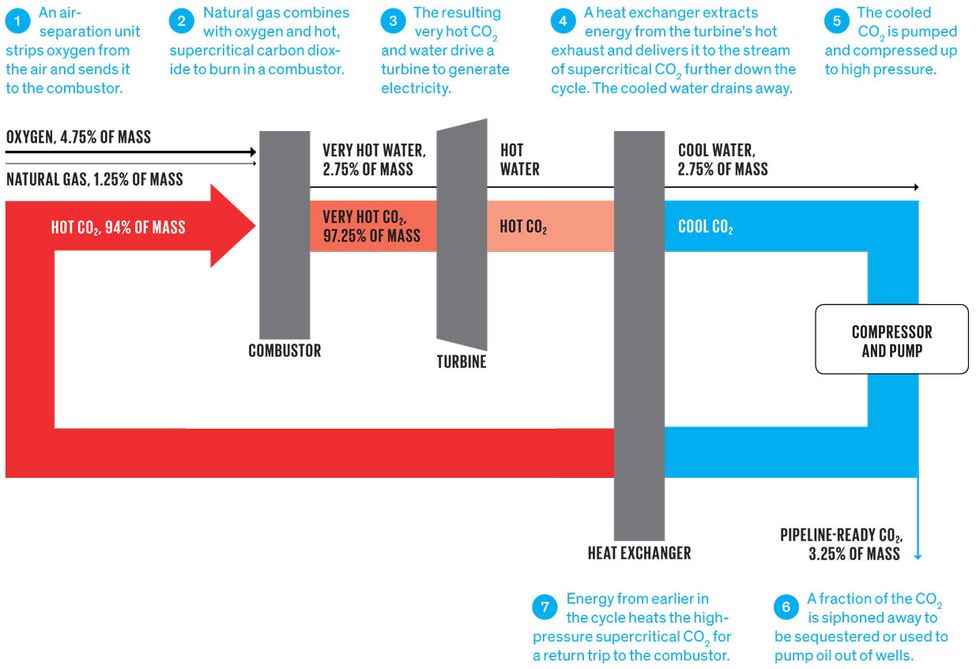This Power Plant Runs on CO2
Carbon capture costs nothing in NET Power’s new plant, which uses supercritical carbon dioxide to drive a turbine
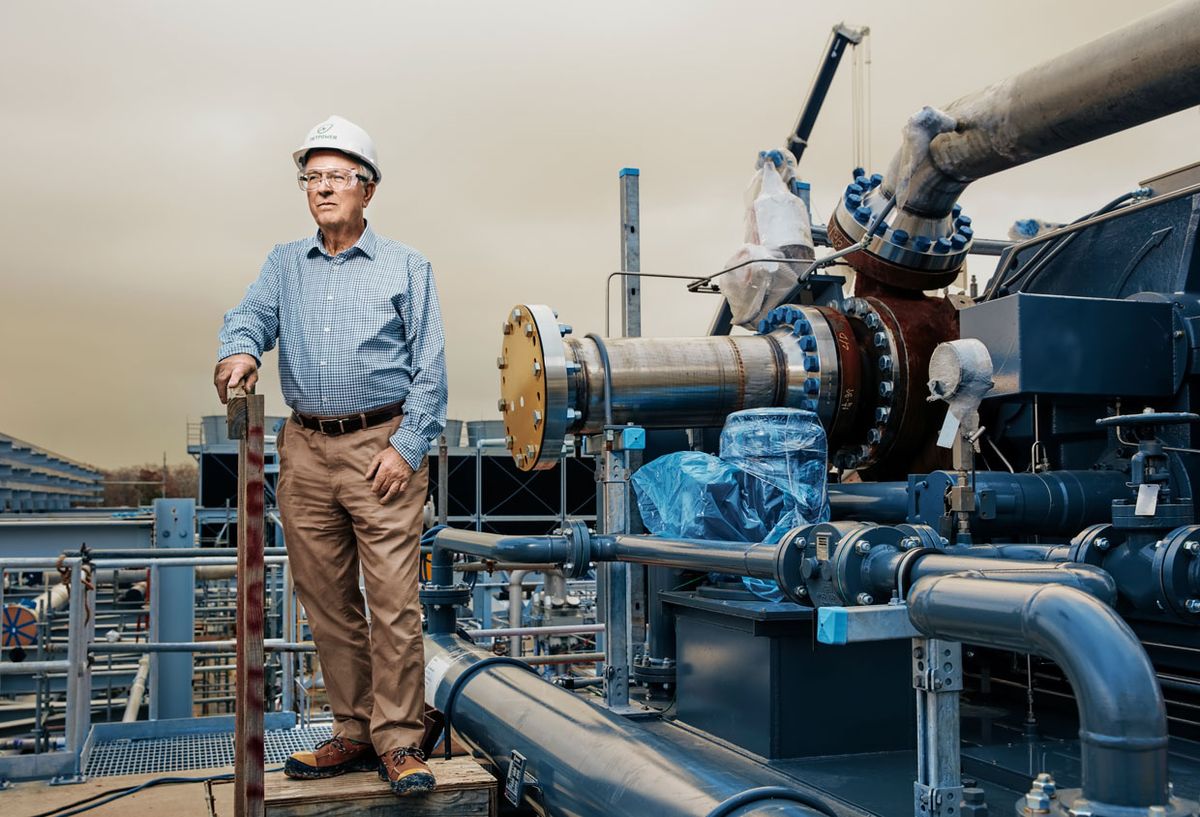
Jump to Articles in this Section
A fire breaks out in your office’s server suite. You grab an extinguisher, aim its nozzle at the blaze, and hit it with a cloud of carbon dioxide. Out goes the fire.
Flames die when doused in CO2. And yet under just the right conditions, CO2 can also sustain combustion. That counterintuitive fact is at the heart of a new power plant being built in the Houston industrial suburb of LaPorte. The natural-gas-fired plant’s novel design, from Durham, N.C.–based NET Power, uses a fuel mix that is 95 percent carbon dioxide at the point of combustion. What’s more, it captures and sequesters carbon dioxide at virtually no additional cost. According to NET Power’s calculations, once the company scales up and rolls out the technology commercially, its plants should cost no more to construct and operate than a traditional natural-gas plant, which simply vents its exhaust into the atmosphere.
The key to making CO2 part of the solution instead of the problem is a strange state of matter known as a supercritical fluid. Above a certain temperature and pressure—31.1 °C, or a summer day in Phoenix, and 7.39 megapascals, or about 80 percent what you find on the surface of Venus—carbon dioxide turns supercritical. In that state, it can expand like a gas and yet still move with the density of a liquid; it can even dissolve things the way a liquid can. (In fact, it’s used to decaffeinate coffee.)
Supercritical CO2 can be pumped, compressed, and driven to spin a turbine with an efficiency that steam may never reach. Consequently, supercritical CO2 has been proposed and developed for decades as a credible replacement for steam in all sorts of power generation, including nuclear power and concentrated solar towers.
But in LaPorte, Texas, they’re doing something that could have way bigger consequences for climate change than adding a few—though much needed—percentage points to a solar tower’s efficiency stats. After almost a decade of development, NET Power is putting the finishing touches on its US $140 million, 50-megawatt power plant there. The grid-connected plant is being tested this year, and its backers hope to scale up to commercial deployment by 2021.
Burn, Baby, Burn
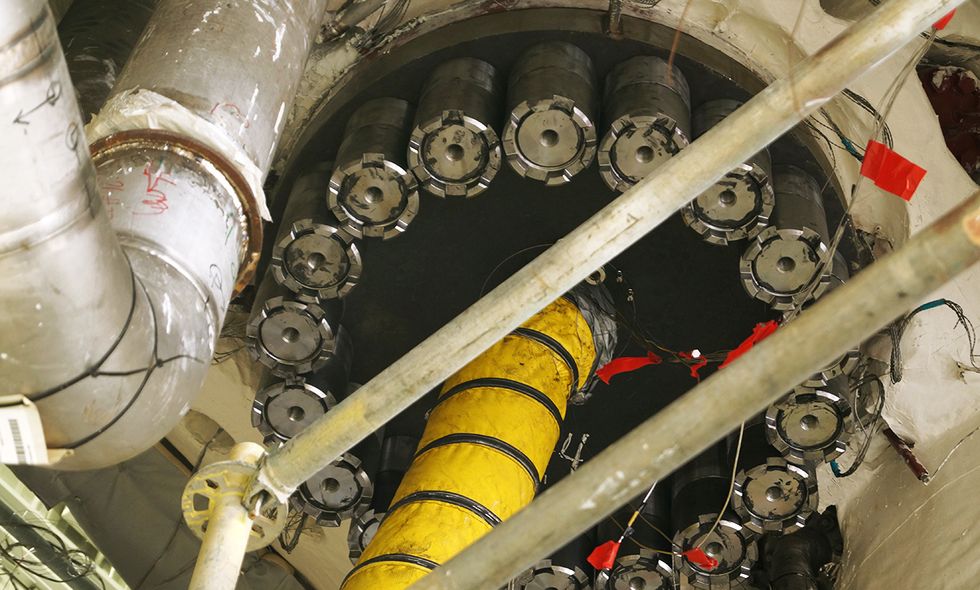
Before his team perfected the Allam cycle, “no one had built a combustor to work at 30 megapascals with diluted fuel and a huge amount of CO2,” says inventor Rodney Allam. Would the combustor sustain a flame when 95 percent of the fuel mix is CO2? Or would the flame go out in the same way that an electrical fire is choked by a CO2 extinguisher?
It took some doing to figure out how to manage the 30-to-1 CO2-to-oxygen ratio, but in January 2013, Allam and the engineers at NET Power succeeded in getting a small-scale combustion chamber to light up and produce a stable flame at a pressure of 1 MPa. By July of that year, test pressure was up to 30 MPa with good results. “We learned in 2013 that the flame is so stable that the combustion does not need to be complicated,” says NET Power CEO Bill Brown.
NET Power fired up its combustor at the La Porte, Texas plant for the first time in May. In this and future tests, the combustor is operating separately from the turbine. The idea is to push the equipment to failure without worrying about damaging the turbine, Toshiba’s $100 million in-kind investment in the plant.
“I hope they break the combustor,” Brown says. “I want to see what this thing can take.” —D.W.
“Their technology is actually excellent technology,” says Nathan Weiland, a research engineer with the U.S. Department of Energy’s National Energy Technology Laboratory, near Pittsburgh, who specializes in supercritical CO2 power generation. “By all accounts it should work well.” If Weiland’s right, then burning fossil fuels without emitting carbon could become about as economical as burning fossil fuels in a conventional power plant without any carbon-control gear.
Supercritical carbon dioxide’s latest use is largely attributable to British inventor Rodney Allam. After a 45-year career with industrial gas manufacturer Air Products and Chemicals, where he served as director of technology development at the European division, he retired for a single weekend in 2005 and began work as a consulting engineer.
In 2009, he met the principals of 8 Rivers Capital, which co-owns NET Power along with Exelon Generating and engineering firm McDermott, and signed on to work with its engineers on a seemingly impossible task. They were to create a technology that could burn fossil fuel without any carbon emissions and generate at an efficiency and capital cost on a par with conventional power plants. In other words, Team Allam aimed to do carbon capture for free.
Following a false start with coal, NET Power’s target became natural-gas-fueled “combined cycle” technology. A combined-cycle plant marries a gas turbine to a steam turbine. The first part burns natural gas, and the exhaust directly spins a turbine to generate electricity. The exhaust, still scorching hot, then enters a heat recovery system to generate steam, which spins a second turbine to produce more electricity.
Ordinarily, this combination delivers an efficiency of up to 52 percent (based on the total energy content of natural gas) and emits around 0.4 kilograms of CO2 per kilowatt-hour. Compare that with a new coal-fired power plant, which emits roughly 8 kg of CO2 per kilowatt-hour. If you simply tack on an existing carbon-capture system to a combined-cycle plant, the power needed to run the added equipment reduces the overall output by about 13 percent. Much of the energy penalty is because the plant’s flue gas is mostly nitrogen from the air used for combustion, and it’s an energy-intensive process to separate the relatively small amount of CO2 from the huge mass of nitrogen.
The NET Power engineers decided they’d need a new type of power cycle, one that basically drops steam from the equation and doesn’t use air. To end up with flue gas that’s almost exclusively CO2 and water, their cycle would have to inhale 95 percent pure oxygen. This concept, called oxyfuel combustion, is at the heart of several carbon-capture schemes. Most of these schemes have drawbacks, though.
First, to deliver the nearly pure oxygen requires attaching an air-separation system to the plant, which of course takes energy to run. Second, the gas might not have enough mass to turn the turbine efficiently. Air is about 75 percent nitrogen by mass, so nitrogen is the main thing driving a typical gas turbine. Without the nitrogen’s mass, the exhaust simply doesn’t have enough momentum. If you try replacing that mass with a lot more oxygen and fuel, the combustion would be so hot that you’d need to make your turbines out of exotic—and expensive—high-temperature alloys, or risk transforming them into melted heaps of slag.
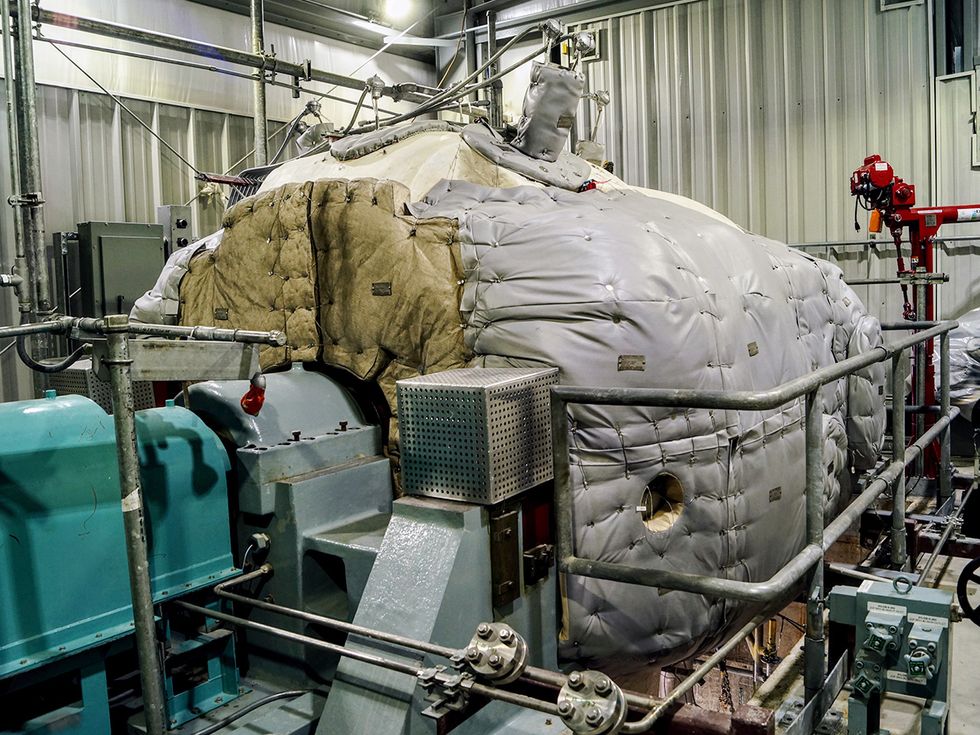
Allam’s counterintuitive approach stemmed from an idea he’d had long before he started working at NET Power: Burn the fuel and oxygen in supercritical CO2 and the resulting exhaust has the necessary mass to spin the turbine. The heat of combustion expands the supercritical CO2 exhaust through a turbine, from which it exits at around 3 MPa. The hot exhaust enters a heat exchanger, which transfers the gas’s thermal energy to a supercritical CO2 stream that’s headed back to the combustor.
The turbine exhaust, meanwhile, exits the heat exchanger, having been cooled to air temperature. It falls out of its supercritical state and the water vapor produced in combustion condenses and drains away. The now highly pure CO2 stream is then compressed, cooled, and pumped up to a supercritical 30 MPa for a return trip to the combustor.
The pumping step represents one key to the cycle’s performance. Allam and his team realized that if they used compression alone to pressurize the CO2 from 3 MPa all the way to about 30 MPa, the energy required would sap the cycle’s overall efficiency. That’s because compressing CO2, which boosts pressure by decreasing gas volume, takes more energy than pumping it, which increases pressure by adding mass. So in the Allam cycle, the CO2 is compressed to a superfluid at around 8 MPa, cooled, and then efficiently pumped to 30 MPa.
The Allam Cycle
By using supercritical carbon dioxide as most of the mass, the Allam cycle can burn natural gas to generate electricity while delivering carbon dioxide at the proper temperature and pressure for sequestration.
After compression and pumping, most of the CO2 makes a pass through the other end of the heat exchanger to get warmed up before flowing to the combustor. But something less than 5 percent of the CO2 is siphoned off to a high-pressure pipeline for sequestration underground or other uses.
So to sum up: The Allam cycle uses its own exhaust to drive a turbine and its own compressors and pumps to sequester carbon. In other words, carbon capture is integral to the process.
“I am absolutely confident what we have will work,” says Allam. “It’s pretty well standard equipment, and there is nothing innovative in the turbine.”
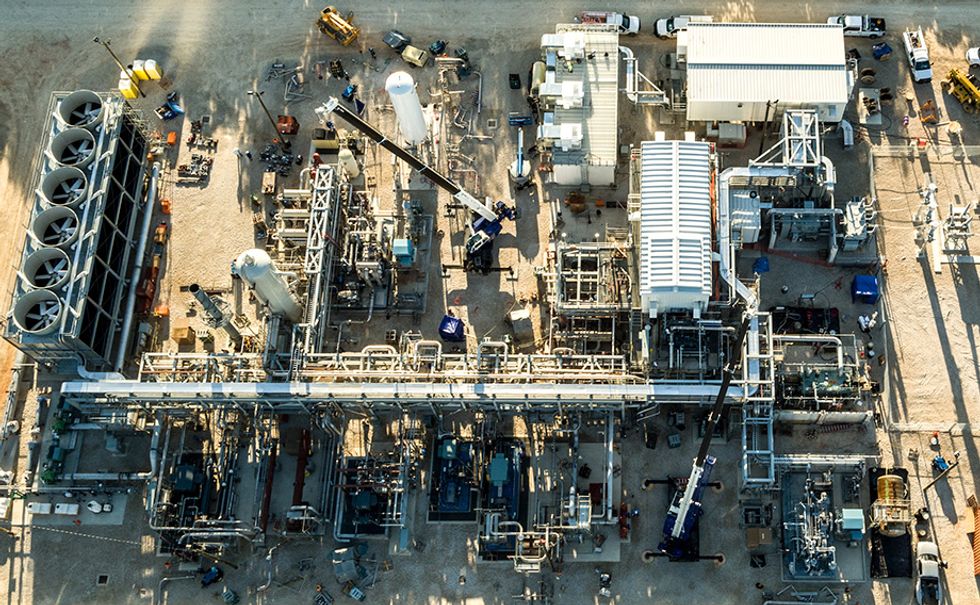
In LaPorte, NET Power’s low-profile plant sits next to an air-separation facility owned by the French firm Air Liquide. You reach it by a gravel road that splits a screen of trees and overgrowth. On a foggy January morning, the plant’s most imposing feature is its bank of cooling towers, conventional fare for an industrial plant. A pair of construction cranes idle nearby.
Overshadowed in the maze of piping and structural steel is the turbine itself, which is exceptional mostly for its small size. The combination of high pressure and high temperature means the footprint of the turbine is not much larger than that of a family minivan. (A conventional turbine with about the same output is the size of a city bus, by comparison.) Project backers are counting on the smaller footprint to help improve the venture’s overall economics.
NET Power’s business plan calls for selling some of the industrial gases that are produced. In particular, nitrogen pulled from the air-separation unit could be sold to fertilizer plants, and other trace gases could go to chemical production and welding.
The plan also depends on the captured carbon dioxide being used productively. Right now, one growing market for CO2 is using it to drive hard-to-access oil out of the ground. Pipelines already stretch through Colorado, New Mexico, and Texas to deliver naturally occurring supplies of the gas to oil companies. Occidental Petroleum Corp.’s CO2 use in West Texas alone amounts to about 100,000 metric tons a day, equal to the output of 45 NET Power plants.
While it might seem counterproductive to use a zero-emission technology to help push more fossil fuel out of the ground, experts point out that even in a low-carbon world, we’ll still need oil as the key feedstock for the petrochemical and plastics industries. And it may be only a matter of time before there is a price for carbon that will make such uses less economical. Already in the United States, a recently passed law offers tax credits worth $50 per metric ton of CO2 buried but only $30 per metric ton used for oil production.
Assuming such industrial gas sales materialize, the net effect would trim the NET Power plant’s levelized cost of electricity (LCOE), a proxy for the price that the plant must receive for its output over its lifetime to break even. On paper, the first plant should have a base LCOE of around $50 per megawatt-hour, according to NET Power. That puts it in the same ballpark as a combined-cycle power plant with no CO2 capture. Once multiple plants are built to scale and with all industrial gas sales factored in, the company forecasts LCOE to fall to around $42/MWh (even without the new tax credits).
As a result, NET Power’s backers say that by the time its 30th plant is on line, the technology could match the construction cost and efficiency—about $1,000 per kilowatt and 50 percent—of today’s combined-cycle power plants. And with no on-site emissions.
But technology doesn’t stand still, and existing turbine designs are evolving to address carbon emissions. For example, in March, Gasunie, Statoil, and Vattenfall tapped Mitsubishi Hitachi Power Systems to convert a 440-MW combined-cycle power plant in the Netherlands to burn hydrogen by 2023. Mitsubishi claims that a gas turbine it is developing has used a 30 percent hydrogen fuel mix. That mixture resulted in a 10 percent reduction in CO2 emissions, compared with natural-gas-fired power generation.
With Allam's technology being tested for only the first time, it’s probably too early to speak with confidence about price, says a chief technology officer with a global turbine manufacturer who asked not to be named. For one thing, the CTO says that air-separation is an expensive, mature technology with little opportunity to eke out much cost savings.
NET Power acknowledges that the air-separation unit is a big expense. But it claims that the cost is largely a wash because the Allam cycle cuts out multiple pieces of equipment that otherwise would be needed to run a conventional combined-cycle plant.
The CTO also marvels at the high pressure that the Allam cycle operates under and its impact on the turbine. “It’s an order of magnitude higher than conventional technology,” he says. NET Power CEO Bill Brown responds that Toshiba showed no concern over the high turbine pressures and that the most substantive modifications to the turbine design were to provide additional coatings on the turbine blades and more layers of insulation.
NET Power is not alone in exploring supercritical CO2 for energy production. Another approach is called indirect firing, explains the DOE’s Weiland. Indirect firing takes heat from a standard turbine’s exhaust and uses it to heat and compress supercritical CO2 for use in what is an otherwise conventional steam cycle. That added process should boost the efficiency by 2 to 4 percentage points over that of a regular steam turbine. So a 550-MW supercritical CO2 plant would save enough fuel to energize 17,500 to 35,000 more homes per year than a 550-MW state-of-the-art steam power plant, based on average annual U.S. household use of 10,800 kWh.

Smil Says…
It’s supercreative, but we’ll need to divert more than 3 billion metric tons of CO2 every year to make a dent in global emissions.
Click here for Vaclav Smil”s commentary on the entire Blueprints for a Miracle special report.
Akron, Ohio–based Echogen Power Systems has designed an 8-MW generator that uses supercritical CO2 to turn waste heat derived from a gas turbine or engine into electricity. A heat exchanger drives the CO2 conversion, and the process yields roughly 20 percent more power than a gas turbine alone.
Supercritical CO2 technology is also being explored with an $113 million facility funded by the DOE project called STEP, or Supercritical Transformational Electric Power. The pilot plant, about 10 MW, will be an indirect-fired system that uses the Brayton cycle. Researchers will use the facility to test components and technologies such as heat exchangers, compressors, and turbines for use with supercritical CO2. The San Antonio, Texas, facility is slated to open in 2019.
Meanwhile 8 Rivers, and its partners are working on a variation of the Allam cycle that would run on syngas (carbon monoxide and hydrogen) derived from coal. The goal is to build a 100- to 300-MW power plant by the early 2020s, most likely in North Dakota, where the CO2 could be used to push oil out of the Bakken Formation.
Even as testing gets under way in LaPorte, NET Power is scouting sites for a commercial-scale facility. CEO Brown says that eight locations are under consideration, in the United States, the United Kingdom, Qatar, and the United Arab Emirates. The key will be local demand for industrial gases and pipeline-quality CO2 for oil production. Greenhouse gas emission rules like those in the European Union may favor the Allam cycle, too.
Expectations are high for success at LaPorte, and Brown is eager to see precisely what this potentially revolutionary technology can do.
This article was updated and corrected to include new information about the plant’s combustor, to correct the nature of the Brayton Cycle, and update the investment in NETL’s facility.
